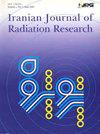Spironolactone ameliorates the radiation-induced late fibrosis in salivary glands in a rat model
Q4 Health Professions
引用次数: 1
Abstract
Background: Management of head and neck cancer includes surgical resection, chemotherapy and radiotherapy (RT). We hypothesized that pre-radiation treatment with a mineralocorticoid receptor (MR) antagonist, spironolactone (S), may have radioprotective effect on salivary glands. Materials and Methods: Study included 30 adult female Wistar albino rats. Rats were divided into four groups (G); G1, control group; G2, RT-only group, G3, S-only group; G4, RT plus S group. Rats were sacrificed at 6th hour; 21st and 100th days after RT. Salivary gland samples were taken for microscopical examination. Results: Periductal-perivascular inflammation scores in 21st and 100th days tended to be higher in G2 than in G4, but the difference was not statistically significant. Periductal-perivascular fibrosis score was significantly different between the groups in 100th day (P: 0.010). Pairwise comparisons revealed that periductal-perivascular fibrosis scores were different between G1 and G2 (P: 0.014), G2 and G3 (P: 0.014), G2 and G4 (P: 0.034). Conclusions: MR blockade with S, when initiated before RT, ameliorates late radiation-induced fibrosis in the submandibular glands.螺内酯改善辐射诱导的大鼠唾液腺晚期纤维化模型
背景:癌症的治疗包括手术切除、化疗和放疗。我们假设盐皮质激素受体(MR)拮抗剂螺内酯(S)的放射前治疗可能对唾液腺具有放射保护作用。材料和方法:研究对象为30只成年雌性Wistar白化大鼠。将大鼠分为四组(G);G1,对照组;G2,仅RT组,G3,仅S组;G4、RT加S组。第6小时处死大鼠;RT后第21天和第100天。取唾液腺样本进行显微镜检查。结果:第21天和第100天导管周围血管炎症评分G2组高于G4组,但差异无统计学意义。在第100天,两组导管周围血管纤维化评分有显著差异(P:0.010)。成对比较显示,G1和G2(P:0.01 4)、G2和G3(P:0.001 4)、G1和G4(P:0.034)之间导管周围血管纤维评分有差异,改善晚期放射性诱导的下颌下腺纤维化。
本文章由计算机程序翻译,如有差异,请以英文原文为准。
求助全文
约1分钟内获得全文
求助全文
来源期刊

Iranian Journal of Radiation Research
RADIOLOGY, NUCLEAR MEDICINE & MEDICAL IMAGING-
CiteScore
0.67
自引率
0.00%
发文量
0
审稿时长
>12 weeks
期刊介绍:
Iranian Journal of Radiation Research (IJRR) publishes original scientific research and clinical investigations related to radiation oncology, radiation biology, and Medical and health physics. The clinical studies submitted for publication include experimental studies of combined modality treatment, especially chemoradiotherapy approaches, and relevant innovations in hyperthermia, brachytherapy, high LET irradiation, nuclear medicine, dosimetry, tumor imaging, radiation treatment planning, radiosensitizers, and radioprotectors. All manuscripts must pass stringent peer-review and only papers that are rated of high scientific quality are accepted.
 求助内容:
求助内容: 应助结果提醒方式:
应助结果提醒方式:


